39 Days Yunnan 25 Ethnic Minorities Discovery and Photography Tour
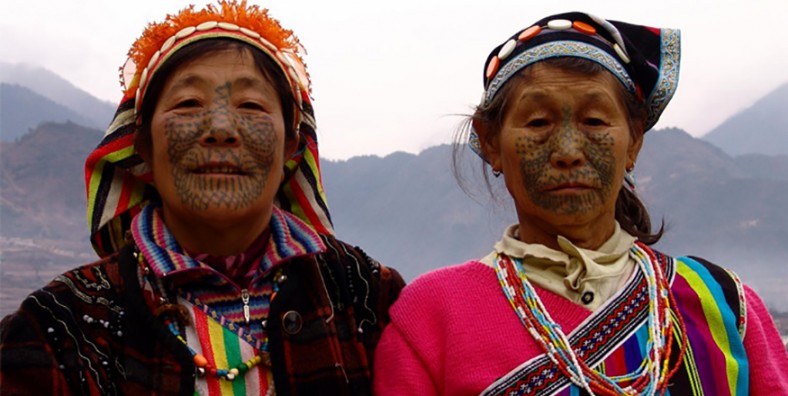
Tour Overview
Yunnan is a microcosm of China in the areas of minority affairs and nationality relations. The province has 25 minority groups, nearly half of the countries total ( 56...
Code of Tour: YET0000013814
Length of Travel: 40 Day
Destinations of Tour: Kunming--Shilin County-Luliang-Luoping-Puzhehei-Bamei-Jianshui-Yuanyang-Mengla-Menglun-Jinghong-Menghai-Jingmai-Lancang-Cangyuan-Mangshi-Ruili-Tengchong-Fugong-Bingzhongluo-Cizhong-Meili Snow Mountain-Shangrila-Lijiang-Dali-Kunming
Departure City: Kunming
Price of Tour: Request
Type of Tour:
Features of Tour: Culture Minorities Photograph ethnic villages
Yunnan is a microcosm of China in the areas of minority affairs and nationality relations. The province has 25 minority groups, nearly half of the countries total ( 56 ethnic groups ). With such ethnic diversity it is important to ask the question: what criteria are used to determine minority status and classification? Basically, there are five ways: Race , Language, Culture, Religion, History. Except 25 minorities mentioned in Yunnan, there are three kinds of the Peoples, for the reason of they are not the really a kind of minority in China . But they are the certain branches of the minorities. The three Peoples have the special customs which are quite different with their original nations and very interesting in the recent days for their names in tourism of Yunnan.
Highlights:
- Experience the profound history and splendid culture of diverse ethnic groups.
- Discover the ancient ethnic towns and villages.
- Enjoy their traditional festivals and fantastic activities.
Brief Itinerary:
- Day 1 Arrival Kunming
- Day 2 Kunming-Shilin County
- Day 3 Shilin-Luliang-Luoping
- Day 4 Luoping
- Day 5 Luoping-Qiubei-Puzhehei
- Day 6 Puzhehei-Bamei
- Day 7 Bamei-Babao
- Day 8 Babao-Yanshan-Jianshui
- Day 9 Jianshui-Yuanyang
- Day 10 Yuanyang
- Day 11 Yuanyang-Jiangcheng
- Day 12 Jiangcheng-Zhengdong-Mengla
- Day 13 Mengla-Jinghong
- Day 14 Jinghong
- Day 15 Jinghong-Jingmai
- Day 16 Jingmai-Ximeng
- Day 17 Ximeng-Shuangjiang-Cangyuan
- Day 18 Cangyuan
- Day 19 Cangyuan-Zhenkang
- Day 20 Zhenkang-Mangshi
- Day 21 Mangshi-Wanding-Ruili
- Day 22 Ruili-Tengchong
- Day 23 Tengchong
- Day 24 Tengchong-Fugong
- Day 25 Fugong-Bingzhongluo
- Day 26 Bingzhongluo
- Day 27 Bingzhongluo-Gongshan-Cizhong
- Day 28 Cizhong-Feilaisi
- Day 29 Feilaisi-Shangrila
- Day 30 Shangrila
- Day 31 Shangrila-Lijiang
- Day 32 Lijiang
- Day 33 Lijiang-Lugu Lake
- Day 34 Lugu Lake-Lijiang
- Day 35 Lijiang-Shaxi-Dali
- Day 36 Dali-Dalin
- Day 37 Dalin-Dali
- Day 38 Dali-Kunming
- Day 39 Departure from Kunming
Google Map
Detailed Itinerary
Day 1 Arrival Kunming
Sightseeing and Activities: Arrive in Kunming, Green Lake
Accommodation: Kunming
Meals: Lunch
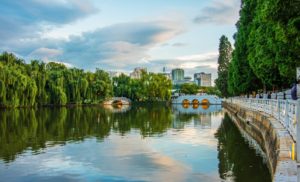
Welcome to Kunming, the Spring City of China! Upon arrival at the Kunming airport/train station, the local tour guide and driver will meet you in the arrival hall and escort you to your hotel.You’ll begin your journey to the diverse and captivating province of Yunnan from the capital city, Kunming.
After a short rest, stroll in the most picturesque park in Kunming urban area – the Green Lake Park,a charming area of tea houses and small boutiques selling handicrafts and beautiful local paintings.. Here you can share the happiness of local people’s doing tai chi, performing local opera, and other vibrant activities. If you visit the park in November or December, you will see the grandeur of huge flocks of red-beaked seagulls that migrate there from Siberia.
Day 2 Kunming-Shilin County
Sightseeing and Activities: Western Hills, Dianchi Lake, Yunnan Ethnic Villages, Yunnan Nationalities Museum
Accommodation: Shilin
Meals: Breakfast, Lunch
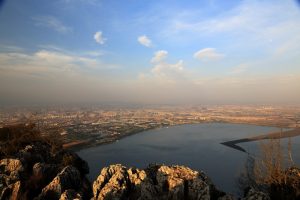
This morning, drive to visit Western Hills. Western Hills boasts an excellent environment with flourishing flowers and dense forest, providing tourists an excellent environment to enjoy the tranquility and marvelous scenery. They have also been given another name – ‘Sleeping Beauty Hills’ for the hills because its skyline looks like a beautiful young lady laying beside Dianchi Lake with her face upward and her hair trailling into water. In the Western Hills, Huating Temple, Taihua Temple, and Sanqing Pavillion are shaded by flourishing woods and tall bamboo bushes. The exquisite Dragon Gate Grotto is built along the precipice cliff.
After lunch, transfer to Yunnan Ethnic Villages. This theme park displays the colorful folklore and architecture of 25 ethnic groups residing in Yunnan Province. The theme park offers shows and performances, folklore and wax museums, as well as replica buildings found in the villages of each ethnic group.Villages of over 25 minorities including the Yi, Dai, Miao, Jingpo, Wa, Hani, Naxi, Dulong and others have been built here. Through various displays and re-creations of the original villages, the Yunnan Ethnic Village displays the diverse local ethnic culture. Villages of different styles are well arranged and show visitors their unique charm. Displaying a variety of buildings, lifestyles, and religious beliefs in the region, the village is a microcosm of Yunnan’s colorful and diverse ethnic culture.
Afterwards, walk to Yunnan Nationalities Museum. Yunnan Nationalities Museum is located on the east bank of Dianchi Lake next to Yunnan Nationalities Village in Kunming City, China. Completed in 1995, it is a comprehensive ethnology museum. Covering an area of over 200 mu, the museum has a building area of 130,000 square meters. It consists of various exhibition halls, office building, report hall, storage and workshops. The ecological environment, religious customs, culture and arts and ethnic relics of the ethnic groups of Yunnan are collected in it.
Day 3 Shilin-Luliang-Luoping
Sightseeing and Activities: Stone Forest, Luliang Colorful Sand Forest, Luoping
Accommodation: Luoping
Meals: Breakfast, Lunch
In the morning, visit Stone Forest (90 kms away, 1.5 hrs’ drive) which is a world natural heritage site and world geological park with amazing karst limestone landform, in the meantime, visit local villages and meet the local Yi ethnic minority people there.
Drive to Luliang County,visit Luliang Colorful Sand Forest, and then drive to Luoping which is known for its rape flowers, every spring, a rape flower festival is held there.
Day 4 Luoping
Sightseeing and Activities: Jiulong Waterfalls, Luobuge Gorge, Duoyi River, Buyi Ethnic Villages, Thousands of Mountains, Rape Flowers Festival
Accommodation: Luoping
Meals: Breakfast, Lunch
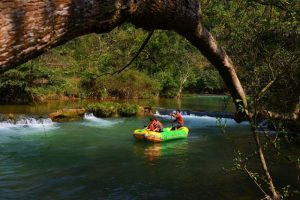
Visit Lubuge Gorge (known as “Small Three Gorges”) and the picturesque Duoyi River which is 12 kilometers long with waterfalls at different levels, where you can also have a glimps of the water mills that shows how the ancient people made use of the natural water resources, then visit Jiulong Waterfalls, a cluster of spectacular waterfalls formed on the Jiulong River, the greatest waterfall there has a drop of 56 meters with width of 112 meters.
Note: If this tour happens during the Rape Flowers Festival from Feb to Mar, you will have one more day option to explore the rape flowers sea in Luoping.
Day 5 Luoping-Qiubei-Puzhehei
Sightseeing and Activities: Puzhehei Scenic Area, Xianren Cave, the boat cruise, Yi and Miao ethnic villages
Accommodation: Puzhehei
Meals: Breakfast, Lunch
Drive to Puzhehei, Qiubei, Wenshan prefecture (3.5 hrs), visit Puzhehei Scenic Area, take a small boat to visit the Karst landscape and lakes, enjoy the local rurality. During your boat cruise, you will see large scale of lotus flowers on the lake. Then disembark at the Qinglongshan wharf and climb Qinglongshan Mountain to see the panorama of Puzhehei. After that, walk to visit the Torch Cave and Kwan-yin Cave.
Day 6 Puzhehei-Bamei
Sightseeing and Activities: Swan Lake, Bamei Village, Big Banyan Tree
Accommodation: Bamei
Meals: Breakfast, Lunch
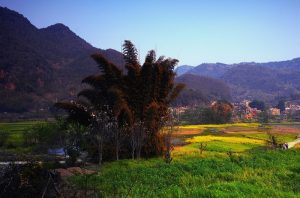
This morning, visit some villages in the scenic area to experience local life. Then visit the “Swan Lake”. After lunch, drive to Guangnan County, then take a boat to Bamei village by passing through the caves. After landing, visit Bamei Village and the Big Banyan Tree, enjoy the peaceful life of Zhuang ethnic people.
The Bamei Village is located on the common boundary of Ake Village and Bada Village in the north of the Guangnan County,Wenshan. It belongs to the Karst topography. The Village is surrounded by green mountains, and through the Village runs all the year round a clear river which is called Tuoniang River. The most interesting thing about the village is that people have to go through a deep and sombrous water cave by boat whenever they want go in and out.When you emerge from the tunnel you will be amazed. In a hidden valley, among a grove of green bamboos and old trees, lies Bamei Village. A blue stream gently flows by, and hard-working farmers silently till the green fields. It’s a picture of another lost Shangri-la. Due to inconvenient location and hard transit, the village escaped attacks by outsiders and the influences of the modern world, staying as unadorned and as pure as they always were. A well-preserved environment and sub-tropical climate made the area a “Promised Land” for the inhabitants.
Day 7 Bamei-Babao
Sightseeing and Activities: Bamei River, Pisa Village, Yanshan County
Accommodation: Babao Town of Wenshan
Meals: Breakfast, Lunch
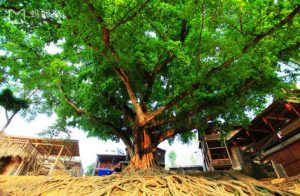
This morning, walk around in Bamei village and visit Bamei River. Have your free time, and enjoy the local life in this village. After lunch, take the boat to get out of the village from another cave.
Then drive to Yanshan County. On the way, you will visit a pure and quaint village of Zhuang ethnic people-Pisa Village(批洒村)in Zhela Township(者腊乡).
Transfer to Babao Town where you will visit the typical Karst landform. Stay in Babao Town.
Day 8 Babao-Yanshan-Gejiu-Jianshui
Sightseeing and Activities: Sanla Waterfall, Shadian Grand Mosque, Jianshui Old Town
Accommodation: Jianshui
Meals: Breakfast, Lunch
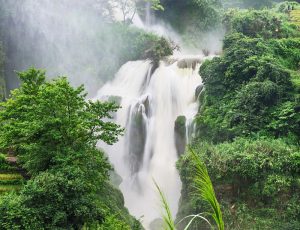
This morning, drive from Yanshan County to Gejiu City in Honghe Autonomous Prefecture for lunch. Then drive to visit the Grand Mosque of Shadian. Grand Mosque of Shadian was originally built in the year of 1684. After several restorations and reconstructions, the new Grand Mosque of Shadian is built into a large-scaled mosque with a construction area of 18,000 square meters. It is able to hold a capacity of 10,000 people to do prayers at a time.
Afterwards, transfer to Jianshui County. Visit Jianshui Old Town and Chaoyang Gate. The ancient city wall of Jianshui was built 600 years ago in Ming Dynasty. Today only Chaoyang tower at the East Gate and Qingyuan tower at the West Gate is left standing. It’s the landmark of Jianshui Ancient Town. Then visit Zhu Family Garden and old wells. The Zhu family garden is a local residence with distinctive features. It was built 100 years ago by a merchant named Zhu. The garden is built as a maze. It’s made up of many courtyard-style folk houses. The houses maintain the upturned eaves, the vivid paintings and the exquisite carvings on the roof beams.
Day 9 Jianshui-Yuanyang
Sightseeing and Activities: Jianshui Confucius Temple, Tuanshan Village and the Garden of Family Zhang, terraced fields of Laohuzui
Accommodation: Mengnong Chieftain Palace
Meals: Breakfast, Lunch
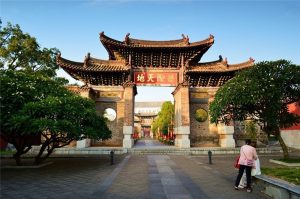
In the morning, visit the Confucius Temple, which has a history of 700 years. It is the second largest Confucius Temple in China. Then you’ll visit Tuanshan Village and the Garden of Family Zhang; Tuanshan Village is a rare surviving example of an intact-albeit neglected-traditional walled Yunnan village compound in southwestern China, and has been added to the 2005 list of internationally significant sites by the World Memorial Fund for Architecture (WMF), an international fund for the protection of world heritage sites.
In the afternoon, you will transfer to Yuanyang and enjoy the sight of terraced fields of Laohuzui (Tiger Mouth) at sunset. Overnight at Mengnong Chieftain Palace.
–Yuanyang is about 300km south of Kunming, renowned for its rice terraces, which claim as the world’s largest and most spectacular one, crafted out by bare hands by the Hani people one thousand years ago and is still in use today. The rice farmers have had to practice ecology and land preservation centuries before those concepts were widely accepted around the world. Without hard work maintaining the terrace walls and irrigation system, the precious top soil would wash down the hillsides into the rivers.
Yuanyang Rice Terrace is a self sustaining ecosystem. During winter to early spring, the entire field is irrigated with spring water from the forest above to rejuvenate and getting prepared for the next season. The Hani people have repeated this for more than a thousand years. There is only one harvest in a year for the Yuanyang Rice Terrace; planting is from March to Oct./Nov. every year.
Optional Sightseeing and Activities:
Lengdun Village of Baohe Town in Gejiu City(个旧市保和乡木花果村委会冷墩村)
Shadian Grand Mosque in Gejiu City (个旧市沙甸清真寺)
Abang Village of Jiasha Town in Gejiu City(个旧市贾沙乡陡岩村委会阿邦村)
Hetian Village in Gejiu City, Honghe(个旧市合田民俗村)
Jiajizhai Village and Pear Blossoms of Jijie Town in Gejiu City(个旧市鸡街镇加级寨村)
Day 10 Yuanyang
Sightseeing and Activities: the sunrise view of Duoyishu Rice Terraces, Bada Rice Terraces, Shengcun Market, Qingkou Village, the sunset view of Laohuzui Rice Terraces
Accommodation: Yuanyang
Meals: Breakfast, Lunch
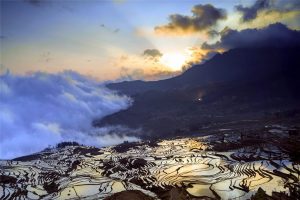
Get up every early in the morning, you’ll drive 30KM to visit Pugao Laozhai Village and enjoy the sunrise of Duoyishu Rice Terrace Fields when the sun appears above the eastern horizon. The terraced fields are ring upon ring and cascade one by one. They go along the hillside up to the sky. You will see the scenery of the terraced fields from the top of the mountains to the bottom. They are all farms under the sunshine and cloud and mist. The landscape is spectacular.
And then, you will visit Qingkou Village and rice terraces where Hani people for generations inhabit. Visit Bada Hani Rice Terrace, Shengcun Market as well.
Transfer back to Xinjie Town.
Day 11 Yuanyang-Luchun-Jiangcheng
Sightseeing and Activities: Laomeng Sunday Market, Lvchun Local Market, Lvchun Hani Ethnic Culture Museum, Lixianjiang River Valley
Accommodation: Jiangcheng
Meals: Breakfast, Lunch
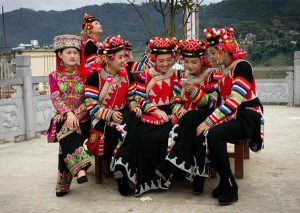
After breakfast, visit the local market in Xinjie Town. Depart from Xinjie Town,drive around 2 hours to Laomeng. If you are lucky enough, you will have chance to enjoy the Laomeng Sunday Market. Laomeng holds the most flamboyant market every Sunday. One can see people from six different ethnic minorities, with women and children dressing up in colourful dresses, different in their own traditional style.
Continue the driving along the banana forest and some rice terraces, you arrive at Lvchun County. Lvchun county, on the south western border of Yunnan Provice, China, just like its name, is a land where the green mountains spread out like a ribbon, the azure water always flows, the winter isn’t too cold, and the summer isn’t too hot.
Pay a visit Lvchun Local Market and Lvchun Hani Ethnic Culture Museum. The main cultural legacy of the worldwide Hani people over several thousand years of development is its unique immaterial culture. Therefore, this museum, in accordance with current advanced theory, has discarded the model of a traditional museum which simply displays a collection of implements, and adopted a model of bringing together local characteristics and the worldwide Hani culture.
After lunch, drive along the Lixianjiang River Valley to Jiangcheng Hani and Yi Autonomous County. Visit Lixianjiang River Valley, Hani ethnic villages, rice terraces on the way.
Optional Sightseeing and Activities:
Huanglianshan Mountain Nature Reserve in Luchun County(绿春黄连山保护区)
Dongzhu Rice Terraces in Luchun County(绿春桐珠梯田)
Lagu Hani Rice Terraces in Luchun County(绿春腊姑哈尼梯田)
Day 12 Jiangcheng-Zhengdong-Mengla
Sightseeing and Activities: Longfu Border, Monument of One Foot in Three Countries, Triple-border Boundary Tablet, Longfu Border Market, Jiangcheng Tea Plantation, Shiceng Dashan Mountain, Place Straddling, Mantan Village, Chenzisanzhai Village of Dai Minority,
Accommodation: Mengla in Xishuangbanna
Meals: Breakfast, Lunch
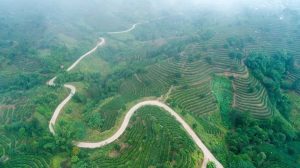
Jiangcheng Hani and Yi Autonomous County is an autonomous county under the jurisdiction of Pu’er City, in southern Yunnan, China, bordering Laos and Vietnam to the south, making it the only county in the province to border more than one country. By road, its seat, the town of Menglie (勐烈镇), is 520 km (320 mi) from Kunming and 145 km (90 mi) from Simao District, the municipal seat of Pu’er.
Drive 1hour to Qushui Town and visit Longfu Border between China,Vietnam and Laos including Monument of One Foot in Three Countries, Triple-border Boundary Tablet, Longfu Border Market (3th,13th,23th). Longfu Border, located in Shiceng Dashan Mountain (Ten Layers Mountain), is famous for the Place Straddling the border of China, Vietnam and Laos.
Drive back to Jiangcheng, visit Jiangcheng Tea Plantation.
Drive to Zhengdong Town, 60KM from Jiangcheng County. Visit Mantan Village and Chenzisanzhai Village of Dai Minority. Chengzi Sanzhai Village consists of Manhe Village (曼贺寨), Manhejing Village (曼贺井寨) Manluanzai Village(曼乱宰寨).
Mantan Village(漫滩傣族村) is a traditional village with Dai people’s characteristics. Dai people has lived there since the Emperor Yongzheng(雍正) of Qing Dynasty(1636 A.D-1912 A.D.). Up to now, Dai people have occupied 95% percent of the population in the village.
Well-reserved natural environment and ethnic dwellings make the village beautiful and quiet. No garbage can be seen when strolling along the roads in the village.
Chenzisanzhai Village(城子三寨村): a unique village with exotic flavors
About 8 kilometers away from Mantan Village sits the Chengzisanzhai Village. It is a small yet ancient village where Dai people have lived there for generations. Traditional customs of Dai people are intactly reserved in the village. Exquisite traditional houses of Dai people can be seen everywhere.
The village borders to Laos and Vietnam. Its unique geographical location contributes to Dai people’s close communication with Southeast Asian countries. Nowadays, local Dai residents still keep the custom of intermarriage with the Lao and the Vietnamese, which endows an kind of exotic flavor to the village.
Drive to Mengla County for overnight.
Options:
Bobiezhai Village of Guoqing Town in Jiangcheng County (江城县国庆乡么等村委会博別寨)
Yiwu Old Town in Mengla County(易武古镇)
Yiwu Ancient Tea Mountain(易武茶山)
Day 13 Mengla-Menglun-Jinghong
Sightseeing and Activities: Wangtianshu Scenic Area, Air Corridor, Menglun Tropical Botanical Garden
Accommodation: Jinghong in Xishuangbanna
Meals: Breakfast, Lunch
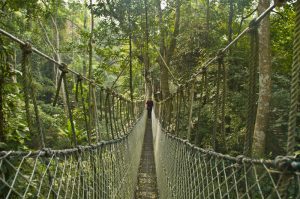
Visit Wangtianshu Scenic Area, which is the only oasis at 21 degrees north latitude, and has been recognized internationally as China’s unique tropical rainforest. Then walk in the Air Corridor (only the first entrance tickets of Wangtianshu Scenic Area and Air Corridor are included).
Drive to Menglun and take a tour of the Menglun Tropical Botanical Garden. As the home to many rare flora and endangered fauna, Xishuangbanna is an excellent place to take in the unique beauty of sub-tropical nature and biodiversity in China. Take a visit to the Menglun Tropical Botanical Garden and observe beautiful flowers, shrubbery, and trees in the spacious garden. If you go early enough in the morning, you can see the sunrise cast a dreamy golden glow over the garden.
Drive to Jinghong City for overnight.
Options:
Daka Village (Ake Ethnic People) of Menglun Town in Mengla County(勐腊县勐仑镇大卡村(阿克寨)
Day 14 Jinghong
Sightseeing and Activities: Ganlanba Morning Market, Dai Ethnic Garden, Mengle Great Buddha Temple, Manting Park, enjoy Dai Water Splashing Festival
Accommodation: Jinghong in Xishuangbanna
Meals: Breakfast, Lunch
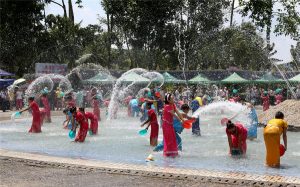
Take one day tour to Ganlanba Morning Market, Dai Ethnic Garden, Mengle Temple.
In the morning visit Ganlanba Morning Market, water Dai villages, Burmese temple and rubber garden on the way. Visit Dai Ethnic Garden, located in the Ganlan Basin in Menghan County, proudly holds a national 4A rating as one of China’s top scenic spots. Within the Dai Ethnic Garden, five Dai villages – Manjiang, Manchunman, Manting, ManZha, and Manga – cover an area of 3.36 square kilometers and consist of 309 families, or 1487 individual villagers.
Transfer back to Jinghong in the afternoon and pay a visit Mengle Temple. Mengle Great Buddha Temple was built to memorize a beautiful Dai Minority queen who was a pious Buddhist during Ming dynasty (1368-1644), which was destroyed during a war in 1848 and what we see today was rebuilt in 2007. Notable for its peculiar shape which resembles a sitting Buddha, Mengle Great Buddha Temple, the largest Theravada Buddhist temple in China, is the most sacred and important religion site of Dai people.
Visit Manting Park which is a modern park that measures about 30 acres in Jinghong in Xishuangbanna. It has a large new Buddhist temple called Zongfo Si. There is a display of ethnic architecture, and people entertain themselves by water fights during the Dai Water Splashing Festival each year. Entertainment is presented in the evening.
Day 15 Jinghong-Menghai-Jingmai
Sightseeing and Activities: Jingmai Tea Mountain, Jinghong in Xishuangbanna, Mengjinglai Dai Ethnic Village, One Tree Forest, Jingzhen Octagonal Pavilion,
Accommodation: Puer
Meals: Breakfast, Lunch
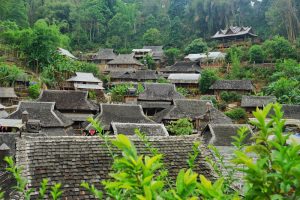
Transfer to Daluo Town, visit Daluo Border between Myanmar and China, Daluo town is located in southwest of Menghai County. The southeast is Bulangshan Mountain, the southwest and west are bordering on the Myanmar with the national boundary of 36.5 kilometers.With a total area of 400 square kilometers and superior geographical advantage, and being 81 kilometers away from Menghai County, Daluo is an important port in Yunnan province.
Visit Mengjinglai Dai Ethnic Village. Mengjinglai is the most outstanding China-Myanmar village. It’s located in the southwest of Xishuangbanna, Menghai Town. The crystal clear Daluo River flows from the west of the village forms the natural borders for both countries.
Visit One Tree Forest. Some aerial roots will grow from the trunk of the big banyan tree to whose base they would twine. Through the branches of the banyan tree breaks 32 aerial roots that are hanging down into the earth to be an aerial roots jungle. These straight aerial roots stand in lines like the soldiers who protect their motherland at the frontier, which makes people respectful. Therefore, the One-Tree-Forest scenery in Da Luo town is indispensable for the tourists to Xishuangbanna.
Transfer to Xiding Town, visit Xiding Thursday Market if it is the market day today.
Visit Zhanglang Bulang Ethnic Village.
Drive to Menghai County, pay a visit to Jingzhen Octagonal Pavilion. Jingzhen Octagonal Pavilion was built in 1701 during the Qing Dynasty (1644-1911) — the year 1063 according to the Dai calendar. It was originally built in a local Hinayana temple, but the temple was destroyed. The pavilion has retained its former features following three large-scale repairs.
Then drive to Jingmai Village in Huimin Town of Lancang County.
Options:
Day 16 Jingmai-Lancang-Menglian-Ximeng
Sightseeing and Activities: Jingmai-Lancang-Menglian-Ximeng, Lancang Huimin tourist town
Accommodation: Puer
Meals: Breakfast, Lunch
Lancang Huimin tourist town(惠民旅游小镇)(60 Kilometer about 1-hour’s drive) — Jingmai Mangjing Scenic Area(18.7Kilometer about 33-minutes’ drive), including Dapingzhang ancient tea garden, Nuogan water village of Dai, the ancient village of Wengji Blang, Tea Ancestor Temple, — Menglian Xuanfu Sishu(孟连县宣抚司署) — Menglian Golden Pagoda, Menglian Nayun Ancient Town (111 Kilometer about 3-hours’ drive) — Ximeng Mengsuo Longtan Lake (60 Kilometer about 2-hours’ drive) — Muyiji Holy Valley (5 Kilometer about 34-minutes’ drive).
Day 17 Ximeng-Shuangjiang-Cangyuan
Sightseeing and Activities: Ximeng-Shuangjiang-Cangyuan, Icelandic village, tea-making, tea-tasting, Shuangjiang village
Accommodation: Lincang
Meals: Breakfast, Lunch
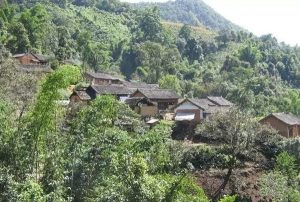
After breakfast, head to Icelandic village from Shuangjiang village to experience making tea by hand. Then after lunch, back to Mengku tea shop to enjoy tea-tasting and visit farmer’s tea-making process.
Mengku Icelandic village ( “Bingdao” in Chinese) in Shuangjiang County, the famous ancient tea village, rich and famous for its large leafed Iceland tea, is one of the county’s first place for cultivating tea. Iceland tea is the main part of the famous Mengku large leafed tea and Icelandic village is the main birthplace of Mengku Tea. This kind of tea has a long history. There are written records during the Ming Dynasty (around 1485), or earlier than Ming period according to the storied unwritten records. As to the origin of the Iceland tea, some believe it was introduced from Xishuangbanna ancient mountain by local Chieftain, while others believe it was introduced from other places.
Day 18 Cangyuan
Sightseeing and Activities: Cangyuan Cliff Painting,
Accommodation: Lincang
Meals: Breakfast, Lunch
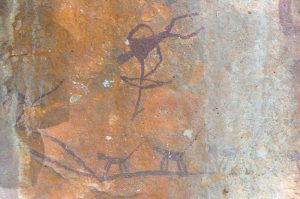
After breakfast, head to visit Cangyuan Cliff Painting. Lincang rock painting is located in the north of Menglai town, Cangyuan county and famous for the 3500- year old rock painting. Up to now, there are 11 pieces of rock paintings found in batches in 1965, 1978 and 1981, mainly distributing in Mengsheng township(勐省乡) and Mengyuan township(勐来乡) , which vividly show the Wa’s activities of hunting, herding, dancing and sacrificing, rich in content and unique in style. So far, Cangyuan rock painting is one of the oldest rock paintings found in China. According to the determination of drawing age,
the rock paintings were measured in the late Neolithic period which is more than 3,000 years ago. On June 25, 2001, Cangyuan rock painting, as a Neolithic relic, was included by the State Council of China in the list of the fifth batch of national relic protection units.
Visit Thousand-Meter Gallery of Chinese painting in the afternoon. Located in the middle part of the scenic area, the mural is about 3 kilometers long, 80-180 meters high and the highest 280 meters. Some cliff surfaces are uneven densely covered with honeycomb dissolved pore, some are smooth just as being cut by a knife or axe, and some are similar with terrace dotted to be colorful by impurities and climbing plants. It is like a giant mural painting, which depicts the vicissitudes of the old earth.
Day 19 Cangyuan-Gengma-Zhenkang
Sightseeing and Activities: Tea-making, pottery-making,
Accommodation: Lincang
Meals: Breakfast, Lunch
After breakfast, head to the scenic spots. Have you own DIY experience in Pu ‘er tea base, and visit Pu ‘er tea farmstead to enjoy tea-tasting and learn local tea culture. Then, go to tea factory to have DIY fun of making tea! Next go to experience Mengyong pottery-making. Drive to Zhenkang county for overnight.
Mengyong pottery and Pu ‘er tea base is a part of the intangible cultural heritage of Yunnan minorities, which is non-commercial and pay more attention to personal experience of tourists.
Day 20 Zhenkang-Mengyang-Mangshi
Sightseeing and Activities: Nujiang River, original forest and ethnic villages
Accommodation: Mangshi in Dehong
Meals: Breakfast, Lunch
Nujiang River, original forest and ethnic villages
Day 21 Mangshi-Wanding-Ruili
Sightseeing and Activities: Menghuan Grand Pagoda, the Peacock Lake, the Pagoda wrapped in the tree, Moli Waterfall and Rain Forest, Jiegao Myanmar and China Border
Accommodation: Ruili in Dehong
Meals:
Menghuan Grand Pagoda, Peacock Lake, the Pagoda wrapped in the tree, Moli Waterfall and Rain Forest, Jiegao Myanmar and China Border
Day 22 Ruili-Longchuan-Yingjiang-Lianghe-Tengchong
Sightseeing and Activities: Jiele Golden Pagoda, One Tree Forest, Dayingjiang River, Nandian Xuanfu Chieftain Palace
Accommodation:
Meals:
Jiele Golden Pagoda, One Tree Forest, Dayingjiang River, Nandian Xuanfu Chieftain Palace
Day 23 Tengchong
Sightseeing and Activities: Rehai Hot Spring, Beihai Wetland Park, Heshun Ancient Town
Accommodation: Tengchong
Meals: Breakfast, Lunch
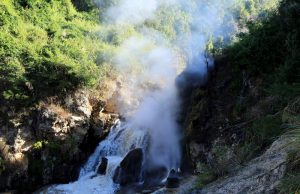
This morning, drive to Rehai Hot Spring. Tengchong is one of China’s three major geothermal areas, known as “Land Abounding in Geothermal Resources”. There are plenty of springs of hot water and hot vapour, called “Hot Sea”. There are quite a number of hot fields as well. Tengchong is a resort where people can travel, take a bath and have medical treatment. The Hot Sea, with an area of 9 square kilometers, lies 20 kilometers away southwest of the county seat and in the center of the geothermal area. There are over 80 springs of hot water and hot vapour, of which there are 14 spring whose temperature reaches 90¡ãC. The spring can be regarded as a rarity as far as their number and geothermal energy are concerned. The most magnificent view is the boiling pool with a temperature of 97¡ãC, so it is called “the Big Boiling Pot” by the local people. There are dozens of big springs of vapour with a temperature of 94¡ãC at the mouths of the springs, where you can steam food.
After that, drive to Beihai Wetland Park. The wetland is surrounded by mountains, located in a special geographical position, and is a typical subtropical volcanic lava barrier lake marsh wetland. The reserve features a “floating blanket style” marsh, complex biodiversity and high productivity. The reserve is not only a garden of national protected plants like Brasenia schreberi and wildwater chestnuts, but it is also a paradise for water birds.
In the afternoon, arrive in Heshun Ancient Town in Tengchong County in the late afternoon, you will be free in Heshun Ancient Town and enjoy the relax life after the wonderful Three Parallel River Grand Canyons adventure tour. Walk around Heshun Old Town, pay a visit to Clothes-Washing Pacillion, Heshun Library,Wenchang Temple and the Anti-Japanese War Museum as well as the local ancient houses.
Day 24 Tengchong-Liuku-Fugong
Sightseeing and Activities: Gaolig Gongshan Mountain Nature Reserve, Nujiang River, Laomudeng Village.
Accommodation: Nujiang
Meals: Breakfast, Lunch
Leave Tengchong, drive to Liuku. Enjoy your day at Nujiang Grand Canyon and visit Laomudeng Village and the bathhouse of Lishu Nationality. It is a tradition to welcome new year that all people take a bath together in the open hot springs by the banks of the river. Then go on driving to Fugong. Sightseeing includes a visit to a suspension bridge and a glide cable. Special Lishu food will be served during dinner. In the evening you will take part in a party with the local people.
Day 25 Fugong-Gongshan-Bingzhongluo
Sightseeing and Activities: Nujiang Grand Canyon, Nu ethnic village, the Suspension Bridges
Accommodation: Bingzhongluo
Meals: Breakfast, Lunch
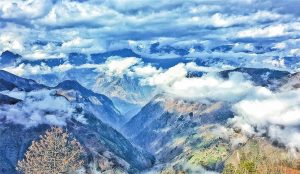
Drive from Fugong to Gongshan (4-hour’s drive), the scenery just got better and better: the river twisted and turned, the valley sides became steeper and there were huge crags and mountains rising beyond-Myanmar was only a few km away over the crest of these green hills. We will pass the famous Shi yue liang, the so-called “bright moon in the mountain”, about an hour outside of Fugong, and source of many Lisu and Nu folkstories. Stop to see the first Bend of the Nujiang River (Salween River) and Mt. Gaoligong. You could also try crossing the Nujiang River hanging from a rope, the Liusuo, a traditional way to cross the river in the olden days when there was no bridge. Then drive to Bingzhongluo (2-hour’s drive).
Day 26 Bingzhongluo
Sightseeing and Activities: Nujiang Grand Canyon, Bingzhongluo Village, Nujiang River (Salween River), the First Bend of Nujiang River, Qiunatong Village, Wuli Village, Dimaluo Village, Chongding Catholic Church
Accommodation: Binzhongluo
Meals: Breakfast, Lunch
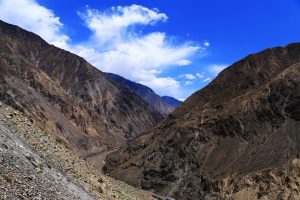
You will have a beautiful hiking tour in Bingzhongluo including the attractions of Qiunatong Village, Wuli Village, Dimaluo Village, Chongding Catholic Church and Nujiang River Grand Canyon.
There are easy and beautiful walks to nearby villages along the Nujiang. A few kilometers outside of town, the river widens and cuts through very deep and dramatic gorges. The road hugs the Nujiang and landslides occur from time to time along the way. It is said that the scenery is especially spectacular after rain, however this also increases potential delays and exacerbates the danger from landslides.
The most beautiful part of Nujiang Gorge starts from Binzhongluo, the northernmost town of the Gorge, where the essential attractions of the Nujiang Gorge are located. Hiking is the best way to enjoy the landscape and an average of 2.5 hours is needed for most tourists to reach the famous “Tea Horse Caravan Route.” Renting a mini bus at Bingzhongluo town is an alternative for the less adventurous sightseers.
On the way to the “Tea-Horse Caravan Route”, one can see the 100-year-old Zhongding Catholic Church built and founded by a French missionary. Shimen Pass is another fantastic section of the gorge along with Wengli (also called Wuli), another stunning landscape lying on a beautiful slope along the river bank. Very near to the Wengli, a carved path is seen on the other bank cliff, the so-called “Tea-Horse Caravan Route”, a path used by traders ferrying their goods between Yunnan and Tibet. At the end of the trekking road, an old hanging bridge and a new one-year-old bridge swing side-by-side.
To those wanderlusts, some trekking routes are worthy of spending days or even weeks longer between Gongshan and Bingzhongluo. Getting 90km further west to the Drung River from Gongshan reveal beautiful virgin forests as well as the kind-hearted Drung ethnic people living their old way of life.
Day 27 Bingzhongluo-Gongshan-Cizhong
Sightseeing and Activities: Nujiang Grand Canyon, Dulong ethnic village, Biluo Snow Mountain, Laowo Mountain
Accommodation: Cizhong in Diqing
Meals: Breakfast, Lunch
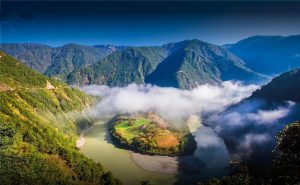
Drive from Bingzhongluo to Gongshan. Stop to visit the First Bend of Nujiang River. Continue the driving along Nujiang Valley to Gongshan County
Drive along the newly built road from Gongshan County to Cizhong,the road is bumpy but the scenery is so fantestic because the view of Mekong River and Nujiang River grand cayons as well as the Biluo Snow Mountain.
Biluo Snow Mountain is located at Lanping churchyard which I continuous 145KM. There are 15 snow mountains, which stand 4000 meter above sea level. The Laowo Mountain is the most beautiful a highest mountain than the others, which is 4500 meters above sea level. It is 3200 meters higher compared with the Lantsang. The original ecosystem has been preserved. The climate changes unconventionally in the mountain. The flowing waterfall is densely 6 covered, edelweiss and lakes are gathered, and it is called the mountain with thousand waterfalls and thousand lakes.
Day 28 Cizhong-Meili Snow Mountain-Feilaisi
Sightseeing and Activities: Tibetan Catholic Church, Feilaisi, Meili Snow Mountain, Three Parallel Rivers of Yunnan Protected Areas,
Accommodation: Feilaisi
Meals: Breakfast, Lunch
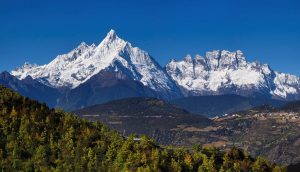
Visit the Tibetan Catholic Church built by French missionaries in 1867, the church is used by Tibetan, Naxi and Lisu people. They still have the grapes planted by missionaries and old the traditional way of making wine. –Lancang River is the longest river flowing from north to south in China. It takes its source from the Zhaqu of the Guangguori Peak of Tanggula Mountain Range in Qinghai Province, China. It is called the Lancang River after it reaches Changdu. The river runs south until it leaves China at the Nanla Bay out of Yunnan Province and therefrom changes its name from the Lancang River to the Mekong River. The Grand Canyon of the Lancang River is famous for not only its deep and long vale, but also the rushing water. The river water is limpid and rushing in winter, but turbid and onrushing in summer. As the river becoming narrow in the Grand Canyon, high waves are striking against the banks and making a sound like thunder. What a fantastic spectacle! Such steep mountains, deep valley and miraculous geographic structure are seldom seen all over the world.
Drive to Mingyong Village. Hike from Mingyong village to Mingyong Glacier (2600m) which is the low altitude glacier of the lowest latitude in the world. Then you will trek down directly to the edge of Meikong River(2,050m/6,724ft) . Walk along the Mekong Grand Canyon and arrive in Xidang Village(2,200m/7,216ft) where you can visit some scattered Tibetan houses in the village.
Arrive in Feilaisi in the late afternoon, you will have a nice sunset view of Meili Snow Mountain from the Sightseeing Platform, where you can see the 13 white pagodas meaning of the 13 peaks of Meili Snow Mountain over 6,000 meters (19,685 feet) above sea level, known as the “Prince’s 13 peaks”.
–Meili Snow Mountain (Meili Xueshan), also called Kawakarpo, is a UNESCO nature site located in Deqin County dividing Yunnan from Tibet, a wonderful place to hike and explore both nature and Tibetan culture.Rising between the Salween River and the Mekong River in the extreme edge of Northwest Yunnan, the Meili Snow Mt. region is part of Three Parallel Rivers of Yunnan Protected Areas. Legend says that the Meili Snow Mountain is a god guarding Tibetan Buddhism. With 13 peaks over 6000m in the range, the main peak Kawakarpo (“Kawagebo” in Chinese) is a sharp snow mountain with an altitude of 6740m,which has never been conquered yet.
Day 29 Feilaisi-Shangrila
Sightseeing and Activities: Benzilan, Baimang Snow Mountain Nature Reserve, the First Bend of Jinsha River or Moon Bend
Accommodation: Shangrila
Meals: Breakfast, Lunch
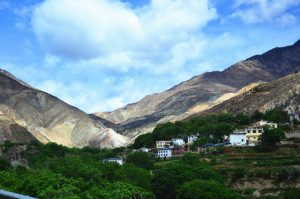
In the morning, drive back to Shangri-la. You will stop at Benzilan for lunch. Visit Baimang Snow Mountain Nature Reserve, you will be able to view Baimang Snow Mountain if the weather is clear, pass the top part of today at 4292m altitude at 156km. After that, visit the First Bend of Jinsha River or Moon Bend, which is the boundary between Sichuan and Yunnan. This is different from the First Bend of Yangtze River in Lijiang City. The bend in Shigu Town changes the flow direction of the Yangtze River but in Benzilan, the Moon Bend is just a grand bend between the mountains with an impressive scenery.
Day 30 Shangrila
Sightseeing and Activities: Songzanlin Monastery, Pudacuo National Park, Shudu Lake
Accommodation: Shangrila
Meals: Breakfast, Lunch
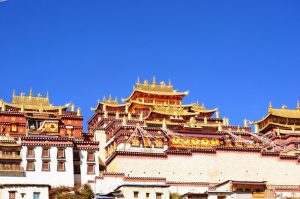
In the morning, visit the Ganden Sumtseling Monastery, the largest Tibetan monastery in Yunnan. Songzanlin Monastery has another alias ‘the little Potala Palace ‘, so named because the whole monastery is in the traditional style with mysterious atmosphere. Walk around Songzanlin Monastery.
And afterwards you’ll visit the tranquil Shudu Lake in Pudacuo National Park. Pudacuo National Park is located in one of the most biologically-diverse regions of the world. While the region comprises only 0.7 percent of China’s land area, it contains more than 20 percent of the country’s plant species, about one-third of its mammal and bird species and almost 100 endangered species.
Finally, you will visit a Tibetan’s family to experience the local life in the bonfire party with Tibetan dance and music and you will try Tibetan home-made yak and cheese.
Day 31 Shangrila-Lijiang
Sightseeing and Activities: Tiger Leaping Gorge, Bendiwan Village, Iron Chain Bridge, Red Army’s Long March Memorial Monument,
Accommodation: Lijiang
Meals: Breakfast, Lunch
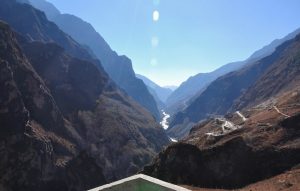
This morning, drive to visit the Tiger Leaping Gorge, the deepest gorge in the world. With 34 rapids of the Yangtze River, it is called the Jinsha in this area because you can find gold in the river. Start the hiking tour of the Tiger Leaping Gorge from the 14KM Point to Halfway Guesthouse in Bendiwan Village for lunch,you will enjoy the wonderful view of Tiger Leaping Gorge and Jade Dragon Snow Mountain from the balcony of Halfway Guesthouse. Trek 1 hour to the Guanyin Temple and Bamboo Forest, and then continue the hiking down to Tinas Hostel in the middle part of the gorge.Meet our driver and transfer to Shangrila.
Then drive to the First Bend on the Yangtze River with imposing gorge scenery, visit the Iron Chain Bridge, the Red Army’s Long March Memorial Monument in the Shigu town. The town of Stone Drum got its name from a large, cylindrical, marble tablet shaped like a drum. The scenery is magnificent as the road running through the Lijiang valley which is filled with wheat fields and drying haystacks.
In the late afternoon, transfer to Lijiang for overnight.
Day 32 Lijiang
Sightseeing and Activities: Jade Dragon Snow Mountain, Lijiang Ancient Town, Ganhaizi Meadow, Baishuihe River, Impression Lijang Ethnic Show, Baisha Village, Baisha Mural
Accommodation: Lijiang
Meals: Breakfast, Lunch
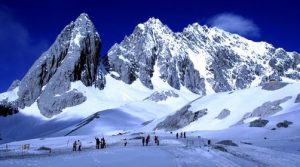
Enjoy the sunrise of the Jade Dragon Snow Mountain and Lijiang Ancient Town in the morning, drive about 30KM to Ganhaizi Meadow(3100M), you will take the sightseeig bus for a short visiting through the Baishuihe River, take the chairlift up to visit Jade Dragon Snow Mountain. The cableway will be arranged according to the condition of the mountain. You will hike around1 hours in the original forest in Spruce Meadow (3200M).
After lunch, you will enjoy the Impression Lijang Ethnic Show directed in Ganhaizi Meadow(3100M). A cultural show demonstrating the traditions and lifestyles of the Naxi, Yi and Bai peoples of the area. The show takes place inside Jade Dragon Snow Mountain Park at 3500m in an outdoor theater specifically designed to showcase the mountain which is used as a backdrop. The production itself was designed by Zhang Yimou, Fan Yue and Wang Chaoge, a cast of over 500 people, and a number of horses. In the afternoon, you’ll stroll through Baisha Village, which is an enchanting traditional Yunnan village. Visit the Baisha Mural about 600 years old, which is one part of the World Cultural Heritage by the UNESCO 1997.
–Jade Dragon Snow Mountain stretches a length of 35 kilometers (22 miles) and a width of 20 kilometers (13 miles). Looking from Lijiang Old Town in the south which is 15 kilometers (nine miles) away, the snow-covered and fog-enlaced mountain resembles a jade dragon lying in the clouds, hence, the name Jade Dragon Snow Mountain. The highest peak named Fan Peak (Shanzidou in Chinese) which is about 5596 meters above sea level. There are three cablecars in the mountain, the fist to the Glacier Park(4500M),the second to Spruce Meadow(3200M), the third to Yak Meadow(3700M).
Day 33 Lijiang-Lugu Lake
Sightseeing and Activities: Lugu Lake, Liwubi Island and Heiwawu Island, Mosuo Culture Museum, take part in Mosuo Bonfire Party
Accommodation: Lugu Lake
Meals: Breakfast, Lunch
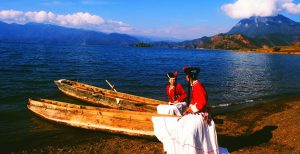
In the morning, dive 4-5 hrs on the spectacle mountain road to visit the mysterious Lugu Lake. On the way, enjoy the beautiful view among the huge mountains and rivers.
Late afternoon, you will take the canoes to visit Liwubi Island and Heiwawu Island in Lugu Lake. Pay a visit to Mosuo Culture Museum and learn the Mosuo ethnic custom in the museum. Enjoy the sunset wonder of Luguhu Lake in Luoshui Village. In the evening, take part in Mosuo Bonfire Party with ethnic dance and singing performance. You will dance and sing with Mosuo boys and girls around a big bonfire in the outdoors theatre.
Day 34 Lugu Lake-Lijiang
Sightseeing and Activities: Zhamei Lamaist Monastery, Ancient Tea-Horse Trade Caravan, Mosuo Market, Ninglang Town
Accommodation: Lijiang
Meals: Breakfast, Lunch
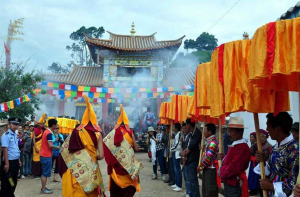
In the morning, you will drive about 20Km to visit the Zhamei Lamaist Monastery which is the biggest lamasery in Moso area Yongning Town. Tibetan people call Yongning as “taluo”, meaning “the way to heaven”. The place the Zhamei Lamasery lies in is called “Zhameige”, which means “no war”. The coincidence of these two names make the Lamasery even famous in Tibet.
Yongning Town is an important town of the Ancient Tea-Horse Trade Caravan from Yunnan to Tibet. Located between Yunnan and Sichuan, Yongning keeps the original ethnic life which is still not damaged by tourists. You will visit Mosuo Market in Yongning Town. We will arrange a Mosuo family to visit and have lunch in Mosuo family, enjoy the Mosuo real life in a village.
Afternoon, drive back to Lijiang. On the way to Ninglang Town,you will stop to visit a Pumi Ethnic Village and Pumi Family.The ancestors of Pumi were a nomadic tribe living in the southern part of Gansu Province and the eastern part of Qinghai Province. Later, their descendants moved south to warmer areas along the Hengduan Mountain Range. After the 13th century, the Pumi ethnic group gradually settled down in Ninglang, Lijiang, Weixi and Lanping counties.
Day 35 Lijiang-Shaxi-Dali
Sightseeing and Activities: Shibaoshan Mountain, Shizhong (Stone Bell) Hills, Shaxi Old Town, Dali Old Town, Foreigner Street, Erhai Lake
Accommodation: Dali
Meals: Breakfast, Lunch
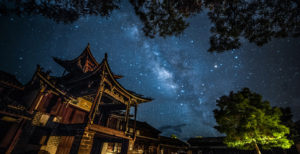
Morning , pick up from your hotel in Lijiang , drive to visit Shibaoshan Mountain. Located 25 km southwest of Jianchuan County, the Shibao (Stone Treasure) Hills are also called the Shizhong (Stone Bell) Hills. Built during the Tang and Song Dynasties, it is considered an official historical site.
Later go ahead to visit Shaxi Old Town The remains of an ancient market town and once an active trade stop on the Southern Silk Road that connected Tibet and China with Southeast Asia and on to Europe. This Road is actually older than the more famous Silk Road (in the North), predating it by at least 300 years. Shaxi has been listed by the World Monuments Fund as one of the world’s 100 most endangered sites.
After the tour , drive to Dali. Visit Dali Old Town. Walk around the Foreigner Street and enjoy the relax time with local people. After climbing up to the City Wall of Dali, you will have panoramic view of the Erhai Lake.
Day 36 Dali-Erhai Lake-Xizhou-Dali
Sightseeing and Activities: Three Pagodas in Chongshen Monastery,cruise in Erhai Lake, Xizhou Town, Xizhou Town,
Accommodation: Dali
Meals: Breakfast, Lunch
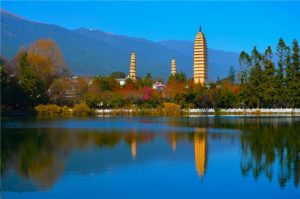
Visit the Three Pagodas in Chongshen Monastery which has a history of over 1,800 years located at the foot of Cangshan Mountain facing to the Erhai Lake. Three Pagodas are made of three ancient independent pagodas forming a symmetrical triangle.
After lunch, you’ll cruise in Erhai Lake by the small boat to the Jinsuo Islet in the east Erhai Lake. There are 200 Bai ethnic families around 1000 people in Jinsuo Island.In Erhai Lake cruise, you will enjoy the green Cangshan Mountain and the Three Pagodas from a far as well as lots of birds and seagulls flying over the lake.
After landing, you will head for Xizhou Town to fully appreciate Bai-style traditional architectural courtyards, taste their fragrant Three-Course Tea and explore their distinctive culture.
Day 37 Dali-Donglianhua Village-Weishan-Dali
Sightseeing and Activities: Donglianhua Village, Tea and Horse Road, Weishan Old Town
Accommodation: Dali
Meals: Breakfast, Lunch
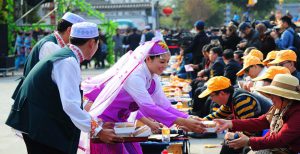
This morning, drive to Weishan County. You will visit Donglianhua Village first. During the Ming and Qing dynasties, they became involved in trade as caravan leaders on the Tea and Horse Road (茶马古道). The courtyards and mansions of village of Donglianhua (东莲花) shows how successful these Chinese Muslims traders were. The Muslims of Weishan (巍山) region in Yunnan (as well as other Chinese regions) belong to the Hui ethnic group (回族). The ancestry of the Hui varies. Some are the descendants of intermarriages between Muslim men of Middle-eastern or Central Asian origins and local women, others are the descendants of Han-Chinese who converted to Islam.
Then transfer to Weishan Old Town. Weishan Old Town is located at the foot of Ailao Mountain. It is a historical and cultural city known as the cradle of Nanzhao Kingdom. First built in Yuan Dynasty, Weishan Old Town has been changed to the brick city and remained the style and features until today. As the place that carry out Tusi System for the longest time in Yunnan, the long history of Weishan breeds numerous temples, echoing with the natural landscape at the diatance.
In the late afternoon, drive back to Dali.
Day 38 Dali-Yunnanyi-Chuxiong-Kunming
Sightseeing and Activities: Yi Ren Old Town, Yunnanyi
Accommodation: Kunming
Meals: Breakfast, Lunch
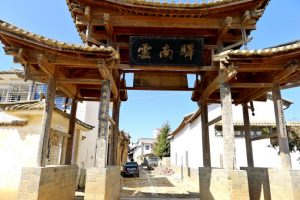
Drive from Dali to Yunnanyi. Yunnanyi is located in Xiangyun County of Dali Prefecture, about four hours’ drive from Kunming. As the earliest place named Yunnan(the place to the south of the colorful cloud), Yunnanyi is the former site of Yunnan County of West Han Dynasty and Yunnan Prefecture of Wei and Jin Dynasties; in the Yuan, Ming and Qing Dynasties, Yizhan (remount or post stations) were set here, so it is named Yunnan Yi. Due to its significant geographic location, Yunnan Yi used to be a must-take position since it can connect Dali, Chengdu, Kunming, South and West Yunnan; a time-honored ancient passage stretches through the small village with well conserved folk residences of Bai.
After lunch, drive to Yi Ren Old Town in Chuxiong City. The Yi Ren old town located at the west of Chuxiong economic development zone, Yunnan. And it is fuses both China and Yi minority national traditional culture as the main key of the antique construction. With fully Yi national minority’s characteristic the entire old town selects material from Yi national minority’s modeling, totem and the color.
In the afternoon, drive to Kunming for overnight.
Day 39 Departure from Kunming
Sightseeing and Activities: Depart from Kunming
Accommodation:
Meals: Breakfast
Depart from Kunming. Service ends.
Recommended Hotels
| Destination | 5 Star | 4 Star | 3 Star | Hostels |
| Kunming | Sofitel Hotel | Kunming Jinjiang Hotel |
Kunming Longteng Hotel |
T&T Story Hotel |
| Shilin | Days Hotel and Suites Tongce Shilin of Wyndham | Bosheng Holiday Hotel | Ashima Business Hotel | Local Hostel |
| Luoping | / | / | / | Local Hostel |
| Puzhehei | / | / | / | YI DA Inn |
| Bamei | / | / | / | Local Hostel |
| Jianshui | Tinziyun Resort |
Lin’an Hotel |
Hongmantian Hotel |
Local Hostel |
| Yuanyang | The Twelve Manor Terraces Hostel | Yunti Hotel (Yuanyang Shengcun) |
Yunshuijian Guesthouse |
Local Hostel |
| Jinghong (Xishuangbanna) |
Jinhong Qixi Hotel |
Jinghong Ninty-Seven Daiyun Theme Hotel | Fanyin Shuyuan Hotel | Jinghong Daixiang Vocational Hotel |
| Lincang | / | Hetang Yuechun Hotel | Yuncheng Hotel | Local Hostel |
| Dehong | Mangshi Hotel | Jingcai Hotel | Huangjia Hotel | Local Hostel |
| Tengchong | Tengchong Guanfang Hotel | Tengchong Empark Grand Hotel | Tengchong Dongfang Xuanyi Holiday Hotel | Local Hostel |
|
Bingzhongluo |
/ | / | / | Local Hostel |
|
Cizhong |
/ | / | / | Songtsam Lodges Cizhong |
| Feilaisi | Guanjing Tiantang Hotel | Mingzhu Hotel | Mingzhu Hotel | Local Hostel |
|
Shangrila |
Tianju Shangri-la |
E-outfitting Boutique Hotel |
Bodhi Boutique Inn | Wu Fu South Yunnan Boutique Inn |
| Lijiang |
InterContinental Hotel |
E-outfitting Boutique Hotel in Shuhe |
Baisha Holiday Hotel | Local Hostel |
| Lugu Lake |
Sealily Lugu Lake Angyue Boutique Hotel |
Sealily Lugu Lake Honeymoon Solu Boutique Holiday Hotel |
Sealily Travel Hotel |
Local Hostel |
| Dali |
Hilton Dali Resort And Spa |
Dali E-outfitting Boutique Hotel |
Taiheju Hotel |
Dali Fengxue Gucheng |
Service Included:
- Admission fees for all of the sightseeing spots listed in the itinerary;
- Meals as listed in the itinerary;
- Hotels as listed in the itinerary;
- Private English-speaking tour guide;
- Private vehicle for transfers & sightseeing with skilled driver;
- Service charge & government taxes;
- Luggage transfers between airports and hotels;
- Domestic train tickets of soft sleeper.
Service Excluded:
- Any arrival and departure international airfares or train tickets;
- Chinese visa fees;
- Excess baggage charged by Airlines;
- Single room supplement;
- Tips to guides and drivers;
- Personal expenses and gratuities to service staff;
- Personal travel accident insurance;
- All optional programs.
Travel Tips:
- Visitors are advised to always carry changes of clothing due to the large variations in temperature between day and night.
- The climate is relatively dry, so drink more water every day.
- Protecting oneself from strong UV radiation at high altitude.
- Protecting oneself from altitude sickness. Lessen the effects of altitude sickness, avoid strenuous exercise and have plenty of rest.
- Respect local customs , habits, and religious beliefs.















